CPU Scaling of Graphics Cards
In order to find out the dependency of various GPUs on fast CPUs, we took our Athlon 64 test bed and while keeping all variables the same, adjusted the clock speed from 1GHz all the way up to 2.6GHz. We ran two groups of cards across the entire spectrum of clock speeds in order to get CPU scaling curves on a per card basis.
The first group of cards were classified as "High End" cards and were all run at 1600 x 1200. All of the cards are graphed on the same graph as to help users determine at what CPU speed it makes sense to purchase a faster card.
The second group of cards were classified as "Mid Range" cards and were all run at 1280 x 1024. All of the cards are graphed on the same graph as to help users determine at what CPU speed it makes sense to purchase a faster card.
By no means were these charts meant to be all inclusive, but they should serve as a good guide for weighing CPU vs. GPU purchases. We also included a benchmark of Half Life 2 deathmatch in the results here using our own custom demo - at_mp_3.
All cards were run at the same high detail settings we performed our Half Life 2 GPU comparison under.
High End Graphics Card CPU Scaling
For our High End cards we’re looking at the Radeon X850 XT Platinum Edition, the Radeon X800 XT and Radeon X800 Pro from ATI. From NVIDIA we have the GeForce 6800 Ultra and GeForce 6800GT. We realize that this isn’t an all encompassing list of GPUs, but you should be able to extrapolate scaling of similar high end cards based on their performance relative to these five.
The most important graph is the first one as it is an average of all six of our Half Life 2 timedemos and gives you the best overall indication of CPU scaling of these GPUs on a holistic level. We have, however, included the individual charts for each timedemo for reference.
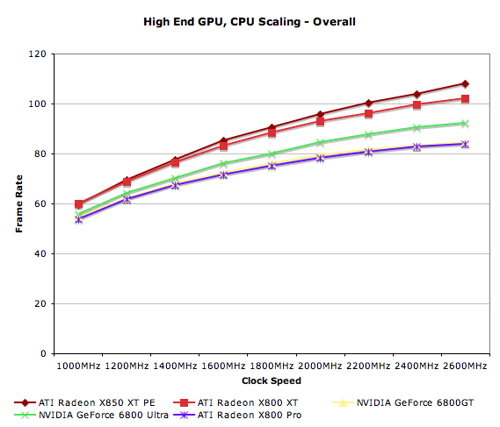
Interestingly enough, at 1600 x 1200, all of these high end GPUs scale quite similarly with CPU speed. We see that at lower speeds, the X850 XT PE performs identically to the X800 XT, it is only after you get above 2.2GHz on the Athlon 64 that the two even begin to separate. The same is not true for the GeForce 6800GT and Ultra, those two really begin separating much earlier on in the game.
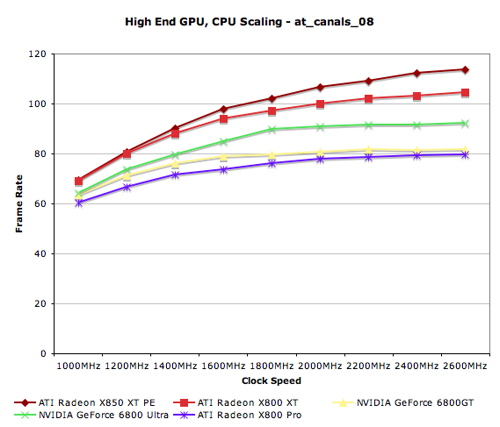
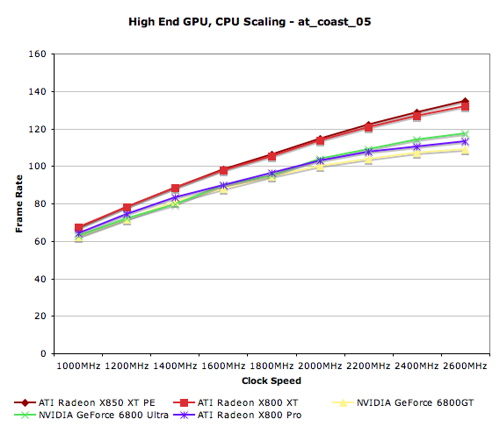
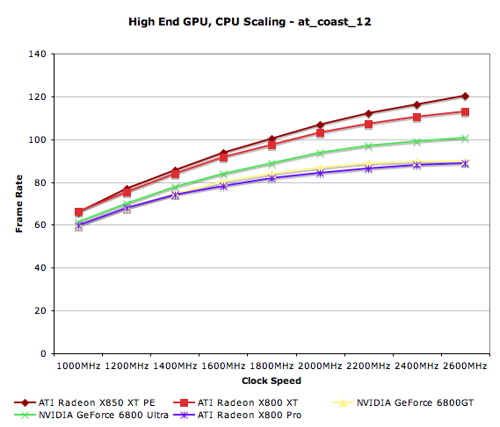
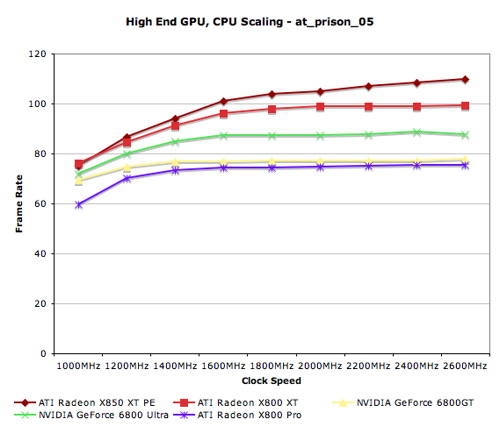
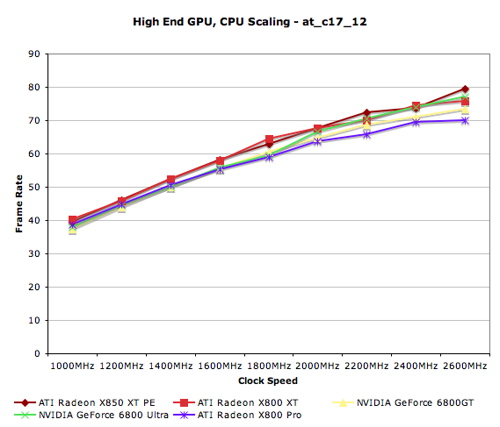











68 Comments
View All Comments
Roooooooooooooooooot - Wednesday, January 26, 2005 - link
Ommmmm ... yes, a very nice article :)
More than any article I've seen, this one made the point about the power of AMD processors for 3D gaming.
"Megahertz Shmegahertz" could have been the title. The 3.8 Pentium running neck and neck with a 2 GHz AMD CPU. Now I understand !!
One place I worked had hundreds of Dell Workstations. They gave us dual xeon ultra-SCSI jobbies. It may not sound like much, but 2 1 GHz Xeon's with an 18 Gig U160 or was it 320 SCSI HDD and an ATI FireGL graphics card was what I had.
I would love to see an article about corporate CAD machines, AMD vs. Intel with various scales of video cards.
bamacre - Wednesday, January 26, 2005 - link
1,000,001 demands for A XP benchies, how about one for high-end Northwood P4's ?? Please?AkumaX - Wednesday, January 26, 2005 - link
I one MEELIONTH the motion, i wish there were a XP barton benchmark somewhere in there, not just w/ the XP3200 (2.2ghz) but also w/ 2.3ghz and 2.4ghz (since most of us appear to also be running o/ced mobiles :P)michael2k - Wednesday, January 26, 2005 - link
What did you expect? People were demanding the HL2 CPU article in the Mac threads... and lo and behold, the next day, Anand has posted the HL2 CPU article.You can either get something now, or you can get something finished... very rarely can you get both :)
Crassus - Wednesday, January 26, 2005 - link
I was also quite surprised that the article still appeared. I'm glad it did, but I think it falls short of Anandtechs high standard:1. For comparison, at least two AXP (two to see how it scales) should be in the test field
2. As previously mentioned, Processor/speed/cache/socket. There is more that just one Athlon 64 3000+
3. Including CAS 2,5 would have been nice as this seems to be the default for people using mainstream DDR3200 RAM
4. What's the deal with the Athlon 3500+ in diagramm 3 on page 2?
Something else bothered me:
Quote: "If you are stuck with one of those older but still well-performing GPUs, don't bother upgrading your CPU unless it's something slower than a 2.4GHz Pentium 4 - you'd be much better served by waiting and upgrading to dual core later on."
Common wisdom seemed to be that especially games don't take advantage of multi-threading. Do you have any new information that upcoming games are geared more towards multiple CPUs/cores/HT?
quanta - Wednesday, January 26, 2005 - link
The test didn't show the impact of using partial precision vs full precision on NVIDIA cards. As some people have mentioned[1], Half-Life 2 doesn't need full 32-bit precision to run smoothly. In effect, NVIDIA card is running in speed crippled by the game's designers.[1] http://3dgpu.com/archives/2004/12/01/boost-perform...
DavidHull - Wednesday, January 26, 2005 - link
I second the need for SLI configurations to be included, as many reviewers have found them to be extremely limited by the CPU.AtaStrumf - Wednesday, January 26, 2005 - link
Interactive 3D charts in flash. Khm,... can it be done?AtaStrumf - Wednesday, January 26, 2005 - link
I was starting to think this article has been bined, but fortunately it wasn't.First of all I agree with the need for an AXP 3200+ in the charts. It's still a very, very common PCU!
Secondly this is only an OK article by Anand's standards. The first thing that really bothered me was how the CPU's are marked by some very long but also very useless names, like
AMD Athlon 64 3400+ (2.4 GHz)
Intel Pentium 4 570 (3.8 GHz)
This takes a lot of room on the carts but still tells me nothing about Cache size or Socket type. I suggest names like:
A64 3400+/S754/512kB/2.4GHz (its shorter and says a lot more)
Same thing for Intel: P4 570/Socket/Cache...
And how in the hell did you come up with CAS3? Most DDR 400 RAM (excluding OEMs) is CAS 2,5 and not 3 or 2. I appreciate the memory tests very much though, I just regret the very basic mistake in the underlaying assumptions.
I understand it was a low priority, seriously delayed article, but I just can't shake the feeling it could have been so much more.
One of these days I'm gonna have to take some time and put together a demo of how data is properly presented.
Questar - Wednesday, January 26, 2005 - link
"Next let’s take a look at at_coast_05, another very GPU limited test that has a good deal of NPC interaction as well as GPU limiting elements:"
How the hell could this be GPU limited if the difference from top to bottom of the graph is > 50%?